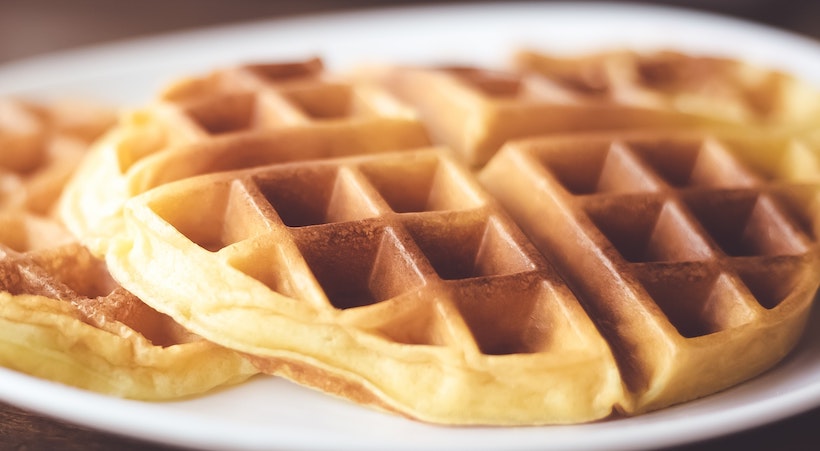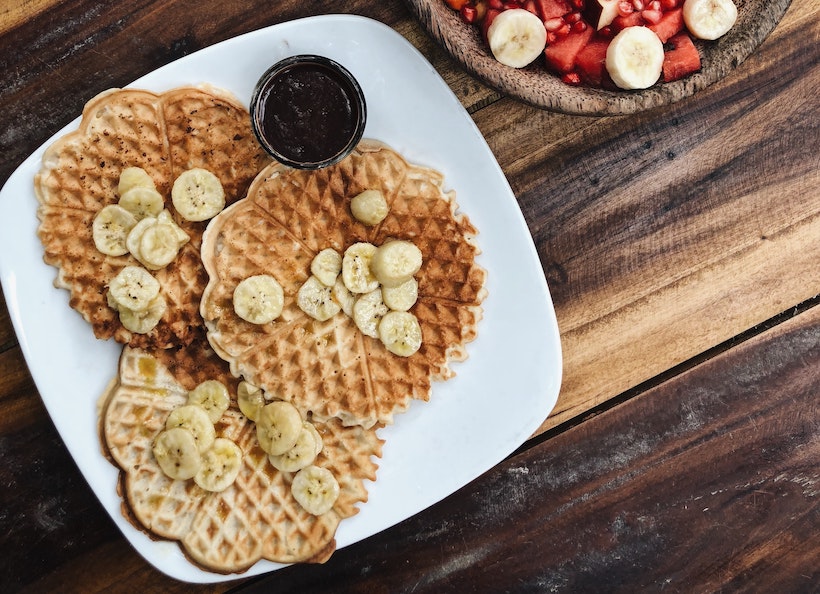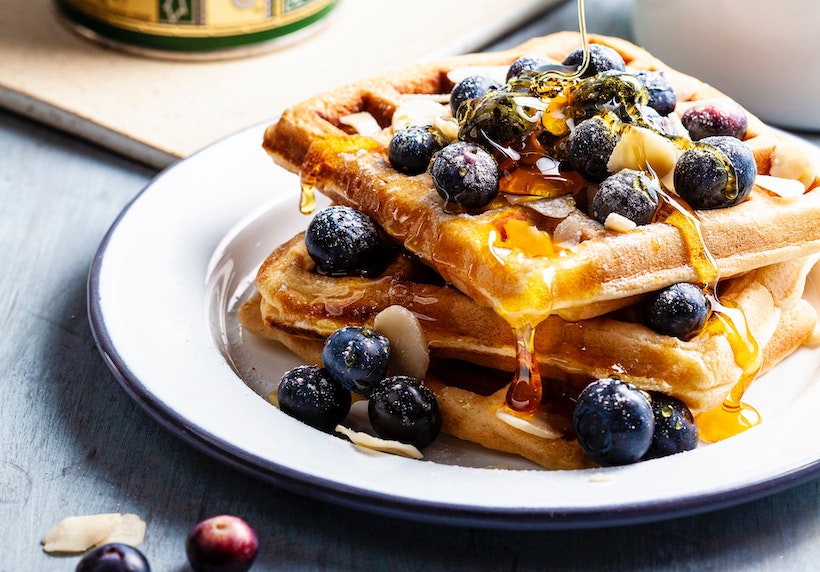Waffles – with their crispy outsides and perfectly sized syrup holes – are a breakfast staple in the US – one that certainly blurs the line between breakfast and dessert.
But beyond your breakfast plate, the history of waffles goes back further than you might expect. Waffles first added their trademark honeycomb design to flatbread sometime in 13th century Europe and spread across the Atlantic with the pilgrims. America industrialized the waffle, cranking out frozen waffles while drawing a stark contrast with the traditional Belgian varieties. And that's just the checkerboard surface!
Interested in finding out more? Let's indulge…

You have to start tracing a food's lineage somewhere. In my opinion, just like with the history of pizza, the story of the waffle really starts with flatbreads.
The earliest ancestors of waffles are unleavened flatbreads, which have been around for thousands of years. In the Fertile Crescent of the Middle East – where human civilization made some of its first important strides – flatbread was a common nutrition source.
They were easy to make (add only flour and water!), transport, and store, contributing to their popularity.
Picking up the journey a bit later, the Ancient Greeks started making obleios, which were simple, flat cakes cooked between two heated metal plates. But these waffle predecessors didn't yet include the grid design of modern waffles.
Christianity later adopted flatbread as an important part of its tradition. Most Christian branches believe the Eucharist, normally a blessed round flatbread, is the body of the savior, Jesus Christ. Street vendors sold the French oublies outside of churches in the Middle Ages. The water presses used to make them often incorporated artistic designs, with crosses or other religious symbols finding popularity.
Beyond our waffle friends, flatbreads are still extremely popular in Middle Eastern countries, India, and the Mediterranean – but their makeup varies across cuisines.
The flatbread was popular in many European cultures for years, but it only got the waffle's characteristic grid pattern in medieval Europe. Nobody knows exactly who invented the waffle or when, but one legend claims it was a medieval knight.
Returning home after a hard day, the knight accidentally sat on an oatcake, still dressed in his armor. The knight left a grid pattern on the bread, and the rest, the story goes, is history.
Most likely, it was a medieval blacksmith who invented the grid pattern we associate with waffles today. After all, the word gaufre in French and the word wafel in Dutch both come from words that mean honeycomb.
The late Middle Ages and Renaissance era saw the popularity of the waffle rise in Europe as street food. There are records of waffles with a honeycomb pattern sold in the streets of England in 1603. In this era, waffles were still simple, consisting of flour, water, and eggs – notably without sugar or flavorings we associate the waffle with today.
At the time, the harder, thinner wafer cookie was also common in fine dining among the upper class (as a dessert). People enjoyed them both rolled up and filled with chocolate or marmalade, like a predecessor to the ice cream cone.
Belgium and Holland soon became waffle hotspots and inventors of many different waffle styles that are still popular today. There's a different, delicious waffle for every taste – from the Liege waffle to the popular Brussels waffle, as well as the caramel-flavored Dutch stroopwafel.

The history of waffles in the United States is nearly as long as the country's history. But the last century or two has seen most of their explosion in popularity: they've gone from food served in upper-class tea parties to mainstream breakfast staples.
Waffles arrived on this side of the Atlantic in the 1620s with pilgrims. Purportedly, they picked up the ways of the waffle from the Dutch as they traveled to America. Lending credence to that theory? They also adopted the name, which evolved from wafel to waffle.
Since colonial days, Northern Americans have served waffles with both sweet and savory twists, including everything from fruit to kidney stew or chicken—the sweet accompaniments for pancakes and waffles in the colonies were molasses and maple syrup.
Indeed, sugar was mostly out. Regular sugar came from England and was too expensive to use in everyday life. Instead, maple syrup was directly available. Colonists harvested it from the naturally grown trees in the northern colonies of New England and New Amsterdam (nowadays, New York).
What has changed a lot since then? The waffle iron.
The first waffle irons used in the US were like the original European models: heavy metal plates with long, wooden handles. They took a lot of strength to maneuver, and the cook couldn't simply leave the waffle on the fire.
Thomas Jefferson, a waffle fanatic, turned this delicacy into something of an upper-class specialty and greatly influenced the history of waffles in America. When Jefferson returned from his post as ambassador to France, he supposedly brought along French waffle irons with smaller handles. He then started hosting "waffle frolics" on his plantation.
In the early days, guests to Jefferson's waffle frolics took turns preparing their own waffles. Later, the parties expanded to other activities (think: frolicking and playing cards) and dropped the tradition's waffle-making signature.
Those early waffle irons weren't only hard to handle but also expensive. Thus, in America's early days, waffles were mostly limited to upper-class tea parties or street vendors who could front the investment.
Post-Civil War America saw a massive waffle breakthrough with the safer waffle iron, designed by Cornelius Swartwout. As a man of Dutch ancestry – who'd probably witnessed many nasty waffle-related burns – he invented a waffle iron that was easy to handle and turn.
National Waffle Day on August 24 coincides with the day Swartwout presented his initial patent in 1869. After this invention, waffles became a common breakfast food in American kitchens, both accessible and safe for the masses.
In 1889, the entrepreneurs Chris Rutt and Charles Underwood developed the first ready-made and self-rising pancake mix. The partners named their brand Aunt Jemima, after a popular character from minstrel shows. They later sold the company to R.T. Davis, who hired Nancy Green, a cook, and storyteller, as the model who until recently graced their products.
In 1906, the Simplex Electric Heating Company manufactured the first electric waffle iron. It was still far from the safe appliance we have in our kitchens today – it had exposed electrical contacts – but it was an improvement over manual irons. In 1911, General Electric launched its first model. The launch wasn't entirely successful—it took a few more years, until 1918, for successful models to arrive.
By that point, waffles were inexpensive to prepare, so they were a popular dessert choice even during the Great Depression. Still, waffle irons weren't as common in American kitchens as they are today. When the price of iron dropped after the Depression, waffle irons became popular in kitchens across the United States.
Another breakthrough in the history of waffles came with the "froffle," or frozen waffle, in 1953. Brothers and owners of the Eggo Food Products company, Sam, Tony, and Frank Dorsa, made the first frozen waffle. Later, they sold their company to Kellogg's, taking the Eggo to stores around the country.
In Brussels' 1958 World's Fair, Belgium introduced waffles topped with whipped cream, powdered sugar, and fruit to a worldwide audience. In the 1962 World's Fair in Seattle, waffles were among the most popular snacks, and waffle bars reported long lines. Still, they only turned into a massive craze two years later.
In the 1964 World's Fair in Flushing, Queens, a vendor named Maurice Vermersch sold "Bel-Gem" waffles, made with a yeasted batter.
He changed the product's name from Brussels waffles to Bel-Gem after realizing that most of his customers couldn't locate Brussels. He thought Americans wouldn't be able to pronounce "Belgian," but that didn't stop the food from eventually taking over high-end waffles in the US.
Vermerchs's waffles were taller than the waffles commonly sold in the United States until then and were finished with a topping of strawberries and whipped cream. They became a true craze at the fair, and Belgian waffles are still popular in the US today.
As for the Vermerch waffles? You can still get them today, served by MariePaule Vermersch. Just don't ask for the recipe – she isn't telling!
The brain behind the first Nike running shoes and former track coach, Bill Bowerman, reportedly had the idea for his sneaker's soles at breakfast. He realized that the waffle iron had the perfect pattern for soles that would work on multiple terrains, even outside the track. And yeah, his prototype used a waffle iron.
It took Bowerman some time to perfect the sole, but Nike still uses the waffle sole in numerous models today.
Dutch wafels became waffles when introduced in the English language, probably to make pronunciation easier. Robert R. Smith's book, Court Cookery: or, the Compleat English Cook, used this word in print for the first time in 1725. The book included a simple recipe for a yeasty batter flavored with nutmeg.

Many countries have a unique style of eating the waffle today, but here are some of the best-known examples.
Not all Belgian waffles are equal. In Belgium, the Liege waffle is a small but thick waffle with sugar clumps. It also has rounded edges.
Brussels waffles are the other Belgian favorite. They're thick and rectangular and have deep pockets for all those yummy sweet toppings. They're also sprinkled with icing sugar on top and leavened with yeast.
The stroopwafel—literally, syrup waffle—is a hard, crumbly cookie made of two thin wafers, joined together with caramel sauce.
If you have a stroopwafel with hot chocolate, coffee, or tea, you can soften it. Just cover your cup with the cookie for a couple of minutes, and it'll become easier to chew!
The United States perfected the waffle as both breakfast and dessert food. American waffles come in all forms and sizes, and the toppings do, too—they can go from sweet syrup to savory bacon, chicken, or the traditional kidney stew. Of course, the frozen waffle is likely the most popular waffle associated with America, however.
Belgian waffles are an American, simplified variation of the Brussels waffle. They're usually leavened with baking soda, unlike their Belgian counterparts. Belgian waffles are also fluffier and thicker than the traditional American waffles and have deep pockets.
Bubble waffles are common street food in Hong Kong, Macau, and Taiwan. They're crispy, sometimes sticky, and taste a lot like eggs. This is why they're also often called egg waffles or eggettes.
There are many theories on the history of fried chicken and waffles, but it's hard to point to the exact origin. Both foods have been common on their own in America since colonial times and served together since the 1620s.
As for the modern pairing and its popularity at restaurants? Two dates really stick out.
So there you have it, the interesting history of this tasty treat. Throughout its time, waffles have been everything from a sweet dessert to a savory pairing – and a religious symbol to a decadent treat.
What's a good bet? Waffles aren't going anywhere – they'll continue to grace our plates for years to come. So dig in, and know you're in good company.
It was great to learn about the history of waffles. THank you for explaining it in a very simple and understanding way. Glad to learn something today.
Thank you
Have a great Day!